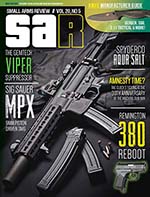Back in Black: The Spyderco Aqua Salt
By The Small Arms Review Editorial Staff
When Spyderco produced their first knife back in 1981, they literally defined the modern tactical folder. Although clip-carried, one-hand opening folding knives with optional serrated edges are commonplace now, Spyderco did it first. And in the process, they also earned a loyal following among savvy military personnel who won’t trust anything else.
That loyalty is not limited to Spyderco’s folding knives. It also applies to their broad selection of fixed-blades, and most notably their Aqua Salt™ model. Originally introduced in 2008, the Aqua Salt was a versatile, do-everything knife with a uniquely shaped drop-point blade. It featured a deep hollow grind that created outstanding edge geometry while maintaining the strength of a full-thickness spine. The grind was accented by a swedge (unsharpened bevel) on the back of the blade that guaranteed an acute, very capable point without sacrificing structural strength. Available in both conventional (“PlainEdge”) and fully-serrated (“SpyderEdge”) edge configurations, the Aqua Salt’s blade was paired with a durable fiberglass-reinforced-nylon (FRN) handle that was injection molded directly onto the tang. Offered in both black and high-visibility yellow, the handle featured Spyderco’s high-traction Bi-Directional Texture™ pattern, which complemented the handle’s ergonomic shape to guarantee a rock-solid grip, even with wet or cold hands.
As a member of Spyderco’s “Salt Series,” the most distinctive thing about the Aqua Salt was that its blade was made from H-1®, an extraordinary nitrogen-enriched steel that is completely impervious to rust.
Traditional steels are produced by adding carbon to iron. This changes the molecular matrix of the metal and gives it the ability to be altered through heat treatment to produce hard, durable tools like knife blades. Unfortunately, carbon-based steels have a fatal flaw: they are vulnerable to rust. While modern high-chromium stainless steels are less susceptible to corrosion than carbon steels, they are not immune to it—especially when used in saltwater environments. Since H-1 uses nitrogen instead of carbon to create the material’s steel-like properties, it eliminates the primary “ingredient” of salt-water corrosion.
H-1 is also an “austenitic” steel that does not require a conventional heat treating process. Instead, the mechanical processes used to shape the blade “work harden” it. Those areas—like the cutting edge—that are “worked” the most become the hardest. The result is a blade material that holds an excellent edge, is incredibly strong and flexible, and is completely impervious to rust.
Users of the first-generation Aqua Salt—including many commercial fishermen and military special operations personnel—absolutely loved it. Although military end users would have preferred non-reflective black-bladed versions, they carried them anyway, often spray painting the blades themselves to subdue them.
Despite the high degree of end-user satisfaction with the knife, it was not a brisk seller and Spyderco ultimately discontinued it in 2010. As soon as they did, its legions of die-hard fans—especially those in the military community—protested and asked that it be brought back. Based on that demand, Spyderco listened and listened well. In 2015, they not only reintroduced the Aqua Salt, they brought it back with a durable black titanium carbonitride (TiCN) coating on the blade.
Like the original version, the new all-black Aqua Salt comes complete with an injection-molded, snap-fit polymer sheath and an angle-adjustable G-Clip™ attachment that supports a wide range of belt and inside-the-waistband carry positions. Eyelets in the sheath also allowed it to be lashed or flex-tied to personal flotation devices, load-bearing vests, packs, and other platforms.
Truly “back in black,” the Spyderco Aqua Salt is an extremely capable, completely rustproof knife that offers proven high performance in some of the world’s most demanding environments. To learn more about it, visit www.spyderco.com.
This article first appeared in Small Arms Review V20N5 (June 2016) |
| SUBSCRIBER COMMENT AREA |
Comments have not been generated for this article.




